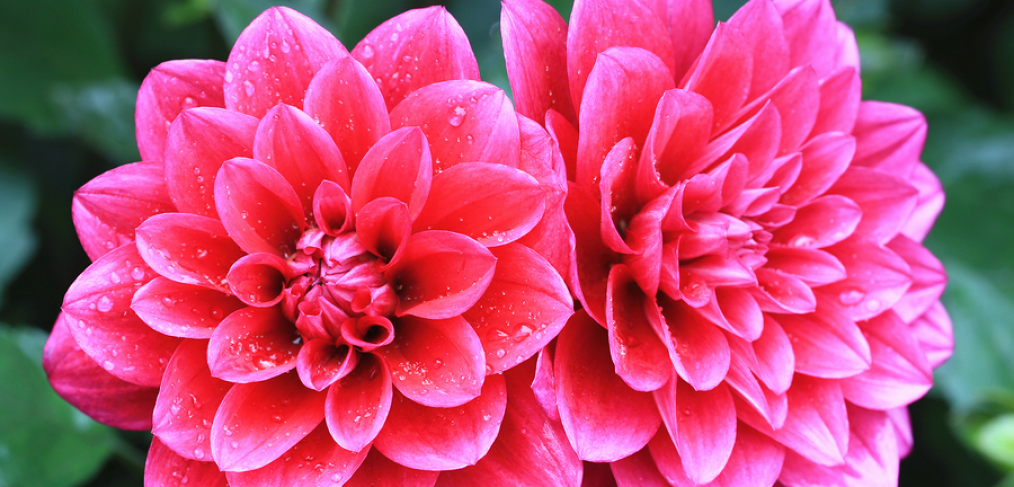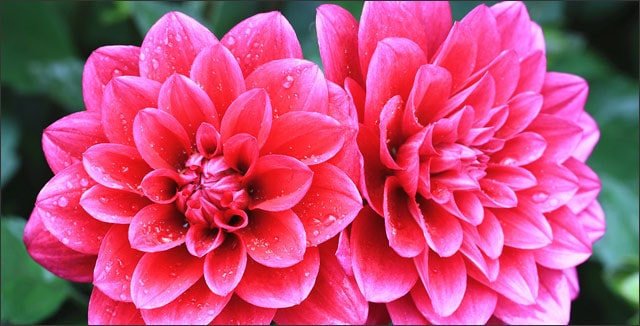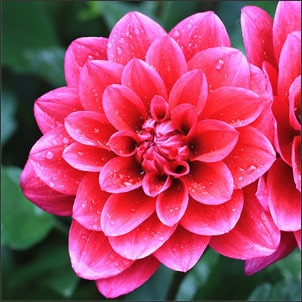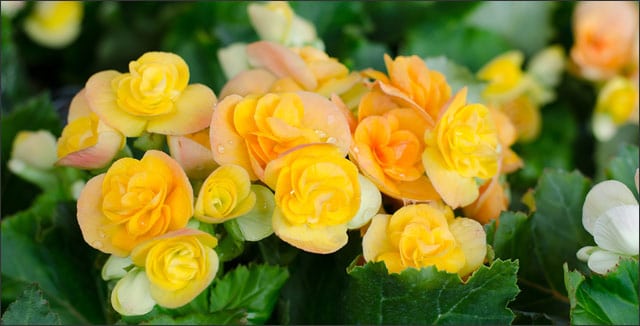
Why You Should Plant These Summer Blooming Bulbs

Did you know there are summer blooming bulbs? Of course you do! Did you know they are actually called tubers?
There are two plants I would like to talk about today: dahlias and tuberous begonias. Both of these flowers start from tubers that can be planted just like bulbs. They originate in tropical climates, so they can’t be planted before the last frost hits. However, if you’re looking for easy show-stoppers in your yard, this is it.
Summer Blooming Bulbs – The Basics
These two flowers have slightly different needs, but the thing they have in common is their need for warmth. Soil temperature needs to be above 55 degrees Fahrenheit before they can be planted. Dahlias can be planted directly in the ground or a container. Begonias on the other hand, need to be started inside first.
These tubers like well-drained soil, much like any plant. Soggy soil will eventually make them rot. Pay attention to the swampy areas of your garden and if you have any, consider planting these in raised beds or containers. You can also mix compost in with your soil before planting to improve drainage.
Did you know bulbs and tubers contain every nutrient they need to grow and bloom? Fertilizer mixed in with the soil is fine, but avoid putting fertilizer directly next to the bulb to avoid burning the roots.
Dahlias

Soil Prep & Planting:
- Enrich and work the soil deep with compost and organic fertilizer.
- Dig the holes deep to ensure soil gets composted down where tubers are planted.
- New tubers or those stored from last Fall can be planted in holes 8’’ deep.
- Plant tubers in clumps of three for large bushes, pointy side down.
- Next to each tuber, plant a sturdy stake. Dahlias need to be staked and supported as they are easily broken in wind and rain.
- Dahlias will grow quickly. Depending on the variety, they will be huge bushes and need a lot of room. Follow instructions on your package or look up the variety for spacing.
- Dahlias need full sun, good soil, and a water source.
- Cover with soil, pat firm, and water
Dahlias Growing Season
One of the best things about dahlias is they are almost maintenance free during growing season. They just grow and put on a show for you to enjoy.
Do you need to disbud your dahlias? Short answer is no. You don’t need to delay that first bloom just to give your plant a better shape if it’s in your garden just for you.
Some growers remove all but the terminal bud (the one at the top of the stem) in the dinner plate variety in order to make the plant put all its energy into that one flower so that one will grow huge. Unless you are competing for biggest flower, this isn’t necessary either.
How about cutting? Of course you can cut them. Who can resist? Just try to cut whole stems and keep the basic shape of the plant. These plants will keep replacing lost branches and budding right up until the frost.

Tuberous Begonias
You may have seen a tuberous begonia as a house plant, but they can be planted in the garden. These flowers are great for those of you with sun-challenged yards because they love shade. They also stay in bloom all season once they bloom, so a lot of people put them in window boxes where they can be regularly watered and fed – which keeps them happy.
Tuberous Begonias Care
Tuberous begonias aren’t the easiest tubers to plant. Start indoors in late winter. February or March are the perfect time to start. If you live in an area with hot summers, it’s best to start them sooner rather than later so they get established before the high temps. You can bring them outdoors once the last frost has hit and either transplant or leave them in containers.
In addition, tuberous begonias love shade. They also need rich soil and regular care. Water every few days or when the soil has dried. They need to be fertilized every other week.
Starting Tuberous Begonias Indoors
Place your planted begonias in a warm place with indirect sunlight – an eastern, western or southern facing window. If you’re out of windows, a heat lamp will do fine for starting begonia tubers and also any other seeds you might be starting indoors.
- Start in a pot twice the size of the tuber. Fill ¾ full with potting soil, peat moss mix – these create acidic conditions and retain moisture better – ⅔ moss, ⅓ potting mixture.
- Begonia tubers have a hollow dip in one side. That’s the top. It may already be sprouting buds, which are very fragile. Carefully place tubers growth-side up.
- Cover with soil and water. Keep the soil moist but not too wet.
- Growth happens 3-4 weeks after planting unless growing conditions are not ideal, then longer.
- Transplant after begonias have sprouted and are two inches tall.
Tuberous begonias will reward you with low (usually only a foot tall) but wide (sometimes 5 or 6 feet) growth and enormous amounts of color all season long. Bring them inside to enjoy as a houseplant after the leaves turn yellow or temps are below 40 degrees Fahrenheit at night.
Or, you can save the tubers for next spring by lifting them and storing in a cool and dry (but not freezing) place. They need to dry for a week before storing so they won’t mold or rot. When dried, place them in a cardboard box full of peat moss or a paper bag.
Take Away
Can you believe it’s already time to start thinking about early spring planting? If you’re already dreaming about colorful blooms, why not start summer blooming bulbs now? Simply start tuberous begonias inside, and plan out your dahlia plot for as soon as the frost disappears.



